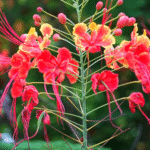Savouring Rambutans: A Juicy Delight from the Tropics – By Bhanuka – eLanka

Rambutan, with its vibrant red skin and soft, translucent flesh, is one of the most loved tropical fruits in Southeast Asia and beyond. Its exotic appearance, sweet flavor, and numerous health benefits make it a fruit worth savouring. Native to Malaysia and Indonesia, rambutan has gained popularity in countries like Sri Lanka, Thailand, the Philippines, and even tropical regions of Central America. For fruit lovers seeking something refreshing and nutritious, the rambutan stands out as a juicy gem from the tropics.
When in season, rambutan trees burst into color, their branches laden with hairy, crimson or yellowish fruits that seem almost otherworldly. The name “rambutan” comes from the Malay word rambut, meaning “hair,” referencing the fruit’s hairy exterior. Inside, however, lies a surprise—peel away the spiny skin and you’ll find a smooth, white or pale pink flesh that’s tender, juicy, and delightfully sweet with just a hint of tartness.
Eating a rambutan is a sensory experience. The fruit is best enjoyed fresh, often chilled to enhance its flavor. To eat it, you gently press or slice the skin until it pops open, revealing the succulent inner pulp wrapped around a small seed. The texture is similar to lychee, but the taste is unique—less floral and more mellow, with a satisfying balance of sweetness. It’s a perfect mid-day treat, ideal for cooling down during the tropical heat or adding a juicy twist to fruit salads, desserts, and smoothies.
Beyond its taste, rambutans are a powerhouse of nutrition. Rich in vitamin C, they boost immunity and promote healthy skin. They also contain iron, calcium, potassium, and dietary fiber, all essential for maintaining energy levels, bone health, and proper digestion. The fruit is low in calories and virtually fat-free, making it a guilt-free snack for health-conscious eaters.
In many cultures, rambutans are not only eaten fresh but are also used in jams, jellies, juices, and even savory dishes. In Sri Lanka, during rambutan season, street markets and fruit stalls are filled with heaps of freshly picked fruit, attracting locals and tourists alike. The sight of families sharing a bundle of rambutans on a sunny afternoon is a familiar and heartwarming scene in the countryside.
For those with a green thumb, growing rambutan trees is an exciting venture. The trees thrive in warm, humid climates with rich soil and regular rainfall. They take a few years to bear fruit, but the reward is a generous harvest that can last for weeks. Gardeners often say that harvesting rambutan from your own tree and eating it straight from the branch is one of the most satisfying experiences nature can offer.
Globally, the demand for rambutan is rising. As people become more adventurous with food and seek natural, nutrient-rich options, exotic fruits like rambutan are appearing more frequently in supermarkets and online grocers. While fresh rambutans are best consumed soon after harvest, canned rambutans in syrup are also available for year-round enjoyment.
The charm of savouring rambutans goes beyond the fruit itself. It’s about enjoying a moment of tropical bliss—whether you’re peeling one open under a shady tree or sharing a bowl with friends and family. Rambutan carries the taste of sunshine, tradition, and nature’s abundance.
In conclusion, rambutans are more than just a curious fruit with a hairy shell. They are a tropical delight that combines flavor, nutrition, and cultural richness. Whether you enjoy them fresh, in a dessert, or as part of a healthy lifestyle, savouring rambutans is a sweet reminder of the wonders nature has to offer. So, the next time you see these spiky red treasures, don’t hesitate—peel, taste, and enjoy the tropical magic of rambutan.






















